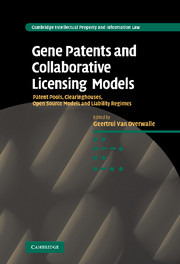 Gene Patents and Collaborative Licensing Models
Gene Patents and Collaborative Licensing Models Book contents
- Frontmatter
- Contents
- List of contributors
- Preface
- Foreword: Jean-Jacques Cassiman
- List of abbreviations
- Part I Patent pools
- 1 Patent pooling for gene-based diagnostic testing. Conceptual framework
- 2 Case 1. The MPEG LA® Licensing Model. What problem does it solve in biopharma and genetics?
- 3 Case 2. The SARS case. IP fragmentation and patent pools
- 4 Critical analysis of patent pools
- Part II Clearinghouses
- Part III Open source models
- Part IV Liability regimes
- Part V Different perspectives
- Part VI Summary and concluding analysis
- Index
- Titles in the series
3 - Case 2. The SARS case. IP fragmentation and patent pools
from Part I - Patent pools
Published online by Cambridge University Press: 14 January 2010
- Frontmatter
- Contents
- List of contributors
- Preface
- Foreword: Jean-Jacques Cassiman
- List of abbreviations
- Part I Patent pools
- 1 Patent pooling for gene-based diagnostic testing. Conceptual framework
- 2 Case 1. The MPEG LA® Licensing Model. What problem does it solve in biopharma and genetics?
- 3 Case 2. The SARS case. IP fragmentation and patent pools
- 4 Critical analysis of patent pools
- Part II Clearinghouses
- Part III Open source models
- Part IV Liability regimes
- Part V Different perspectives
- Part VI Summary and concluding analysis
- Index
- Titles in the series
Summary
Introduction
In the last ten years diverse entities have filed for patents in the field of genomics. The race for patenting DNA sequences started around 1980 growing steadily until reaching its peak by the late nineties. Nowadays, the race seems to have slowed down and the number of patents actually granted in the field of genomics is not significantly high in proportion to the number of applications. However, despite of the possibility that the patenting of DNA decreases due to the increase of patenting thresholds and, the fact that many patent applications are dropped as they prove to lack commercial viability (30% of US patents granted by the 1990s were abandoned by 2005), the amount of patents claiming DNA seems still relevant enough to raise concerns regarding access to the covered technology for further development.
The entities filing patents on DNA sequences range from big pharmaceutical companies to academic institutions. This diversity has resulted in IP fragmentation (one technology/many owners). This fragmentation has originated different concerns and controversy as to whether it represents a problem to R&D and how it may affect public health.
This paper briefly explains the effects of IP fragmentation. It continues with the presentation of patent pools as a solution to the negative effects of IP fragmentation. Finally, it discusses whether a patent pool represents an option for the SARS case.
- Type
- Chapter
- Information
- Gene Patents and Collaborative Licensing ModelsPatent Pools, Clearinghouses, Open Source Models and Liability Regimes, pp. 42 - 49Publisher: Cambridge University PressPrint publication year: 2009
- 1
- Cited by


